Sump pumps are ugly and loud but a necessity to keep the house dry and mold free. As more people are remodeling basements, they are looking for ideas to hide a sump pump in a basement. Choosing good sump pump cover ideas depends upon how the sump pump is plumbed in the basement.
Most sump pump discharge pipes are located some distance away from the basement wall. However, some are right on the wall. Others are inside of a wall. In each of these situations there are suitable ideas to hide a sump pump in the basement.
Table of Contents
Sump Pump Cover Ideas to Hide a Sump Pump in The Basement
A Closet Is the Best Way to Hide Sump Pump Pipes
A closet provides easy access to the sump pump when needed. Also, closets are excellent for muffling loud sump pump noises. Additionally, closet shelves can provide much needed storage space.
Lastly, sump pump closets keep dirt, pets and children from damaging the sump pump system. Of course, keeping the kids and the pets safe is always a priority.
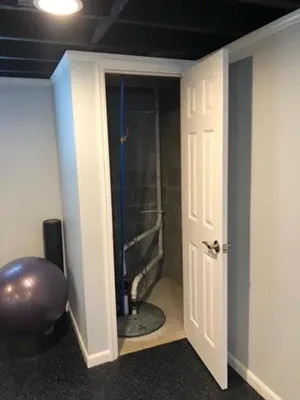
Floor To Ceiling Curtain Sump Pump Cover Ideas
A (nearly) floor to ceiling curtain is one of the fastest ideas to hide a sump pump in a basement. Also, curtains can be inexpensive and are very easy to install.
In basements with bare concrete floors, don’t let the curtain contact the floor. This will prevent curtain damage from the rough concrete.
Also, curtains could absorb moisture from the concrete. Even when concrete looks dry, it could be because air circulation is evaporating the moisture. However, when the curtain contacts the concrete, the curtain can be come damp. This is the result of the curtain not permitting air circulation where it touches the concrete.
Here again, storage shelves can be installed behind the curtains. However, curtains won’t keep the children and pets safe from an operating sump pump. Particularly if you have a battery backup system for the sump pump.
Place Shelving Over the Sump Pump
This is best used when the discharge piping is located inside of a wall. Although, when the pipe is right next to the wall this could be acceptable. However, unless the shelving has a solid back, the sump pump pipes could still be seen.
When using this sump pump cover idea, the bottom shelf must be high enough to provide access to the sump pump. Which means that you may want a door or curtain below the bottom shelf to hide the sump pump.
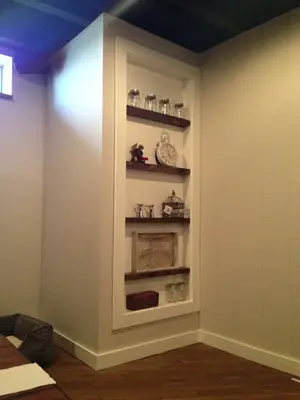
Ideas to Hide a Sump Pump Cover in a Basement
These ideas are best when the discharge pipes are concealed within a wall. Although these ideas could be used even when the pipes are exposed.
Cover The Sump Pump Cover with Carpet
Not all sump pump covers are flat or even flush with the basement floor surface. However, carpeting can be an excellent idea to hide the sump pump in the basement.
Just be sure that the sump basin cover is completely sealed. That way moisture can’t collect under the carpet and cause mold to grow.
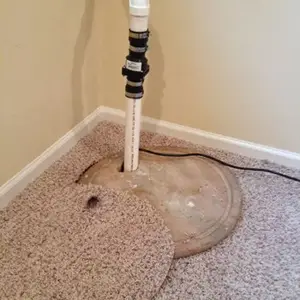
Carpeting when used as a sump pump cover will definitely reduce the normally noisy sump pump.
Need to replace your sump pump? Check out this product review.
Using Plants to Hide the Sump Basin Cover
Artificial plants are a better choice than live plants. Live plants might enable dirt to get into the sump pump basin. Also, artificial plants are easier to move when access to the pump is needed.
Plants could be placed on top of the cover or just around the cover. Taller plants will act as a better screen than short plants. Although short plants will work well under wall hanging shelving.
Large Stuffed Chair or Couch
When the sump pump pit is in the corner of the basement, a large stuffed chair could be placed in front of it. Also, it may be possible to place a chair or couch directly over the sump pump cover.
Just be sure to use an airtight basin cover to prevent the furniture from getting damp.
Also, the bigger the furniture is, the more difficult it will be to remove when needed.
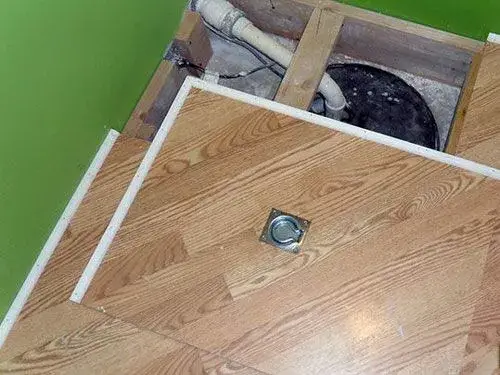
Using Solid Flooring
Practically all basements that need a sump pump system should not use solid flooring that doesn’t let moisture escape. That means using raised flooring that lets air circulate underneath the flooring. The air circulation prevents mold growth and other problems.
The moisture in a concrete floor will make floor paint bubble up and peel off. Also, directly applied floor tile will pop off the floor because of moisture in the floor.
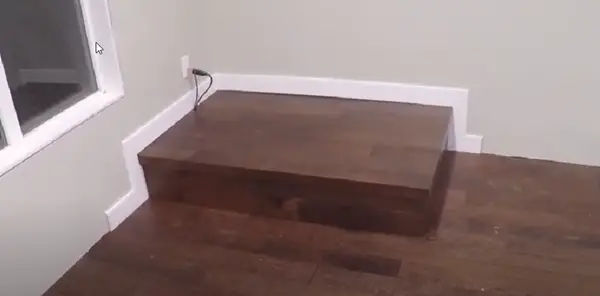
Use A Cabinet or Raised Floor
A regular kitchen or bathroom cabinet can hide a sump pump while providing easy access.
A raised floor is just a larger version of the cabinet idea. It can be more useful than a cabinet but also more expensive.
These two sump pump cover ideas can be very attractive and functional.
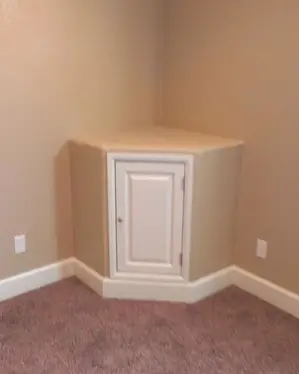
Summary On: Ideas To Hide A Sump Pump In The Basement
The overall best solution is a full closet with a door for access. Second best would be a cabinet because it still provides some height to conceal pipes and has a door. Less convenient are raised floors and carpeting. I hope you found this helpful.
4 Radon Cover for Sump Pump Reviews: Jackel vs RadonAway
Perforated Jackel Sump Basin Review 18 x 24 Inch (SF22A-DR)
For years I have been searching for a plastic or rubber tube to fit in a oval shape whole in my basement that surrounds two sump pumps. To give a leverage of couple of inches in case of the water level in sump pump over flows of water. It is not easy. I can sent you photos if you have any ideas?
The previous owner of the house put the sump pumps below the electrical boxes of the house. I now know why. That area when they poured the cement for the foundation was uneven and they had a little floods in basement. I am trying to avoid this. The basement floors and walls have been painted with massonry paint by me. No cracks or leakage on walls or floors.
Note: Chris sent me this picture of his situation:
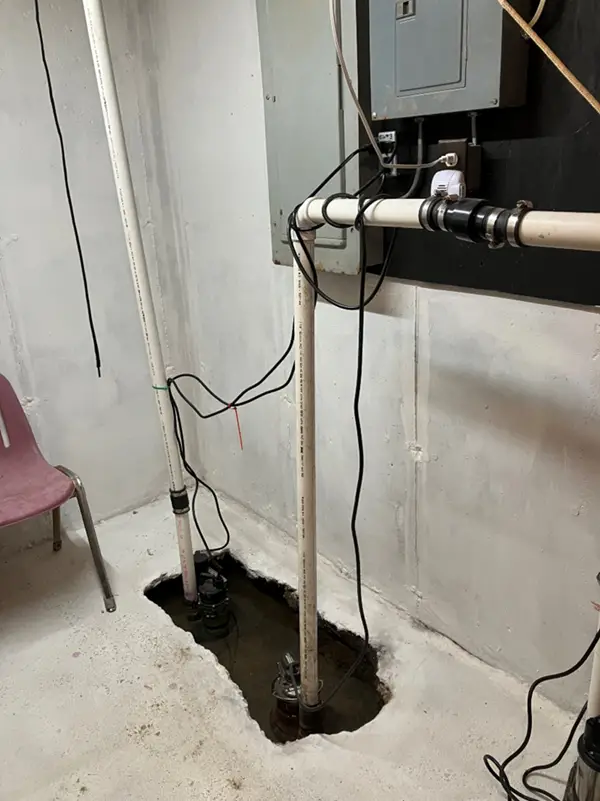
Hi Chris,
You have a couple of options depending upon your DIY skills and budget.
First, let me say that you will never get a bucket or tube that will conform to the existing sump pit and do what you want done.
Option #1:
Install a sump pump basin and lid for each sump pump. This is doable if just one of the sump pumps is able to remove the incoming water. In other words, the second pump is acting as a backup for the first pump.
Obviously, this requires removing and reinstalling the sump pumps. While you are at it, be sure to clean the pump and make sure all of the parts are working.
From the pictures, it looks like some of the concrete floor will need to be removed in order to insert the sump pump basin. Remove the concrete from the side furthest from the wall.
This will probably require repositioning the discharge pipes.
Once both basins are in the pit, pour ¾ inch or bigger washed rock around the basins and up to near the top of the basin. Not all the way up, because now you can pour concrete all around the basins at a level even with the existing floor.
Since you mentioned that you wanted to build a raised wall around the sump pit, that could be done by building a concrete wall around the sump basin.
If both pumps need to be running to handle the water flow, this can still be done, but it gets more complicated. What that tells me is that neither of the pumps are big enough to handle the amount of water by themselves. In other words, the second pump isn’t able to act as a backup incase the first pump fails. If that is the situation, you should consider getting two bigger sump pumps. Also, getting bigger pumps might require bigger diameter discharge pipes.
In this situation you will need a third temporary pump to remove water as you work. That third pump could be kept as a spare for when one of the other pumps needs to be replaced.
Option #2:
Build a concrete wall around the existing sump pit. Make it a few inches thick and as tall as needed. Imbed some bolts with the threads sticking out of the concrete so that a plexiglass lid can be bolted to the top of the concrete wall.
The plexiglass could 2 or 5 pieces depending upon what is easier for you to do.
If five pieces: 2 long pieces, one each on both of the long sides of the sump pump pit. Which would still leave the area between the pumps open. The third piece of plexiglass would be placed between the pumps and would be on top of the two other pieces of plexiglass. Pieces #4 and #5 go on the ends of the sump pit and sit on top of the two long pieces of plexiglass.
This would not be an air tight cover but should keep most everything out of the sump pit.
If using two pieces of plexiglass, each of them will cover one half of the sump pit. The two pieces would meet in between the two pumps. Each of them would have a large slot that would look something like a very thick U shape. Again, this would not be air tight but it will keep the kids and pets out.
Let me know what you think of these ideas and if you have any questions.
Also, with your permission, I would like to edit your question and put my response in the comments section of the article. I would also like to use one or two of your pictures. You can remain anonymous or I can use just your first name or even change the name if you want.
Cheers,
Richard Quick
Note: Chris sent this reply privately:
Hi Richard,
I like Option # 2
By building a small wall all around the two sump pumps and then putting your Plexiglass “U-Shape, qty 2 one for each sump pump.
I like this cover “Jackal Slotted Sump Basin Cover ” If only I can get the size of this Jackal Slotted Sump Basin Cover. Would fit perfectly for both sump pumps. Things will be a spice Engineering design to allow two covers to fit.
This is my idea to start: Pour a thick base of cement around the Sump pump pit “Just the top of the original foundation. then placed bricks not so high, maybe a double layer of bricks with sealing with cement to seal up the gaps. Then laying side by side the “Jackal Slotted Sump Basin Cover”. If, by chance the sump pump fails to work I can repair it by removing the cover and allowing the 2nd pump to continue pumping.